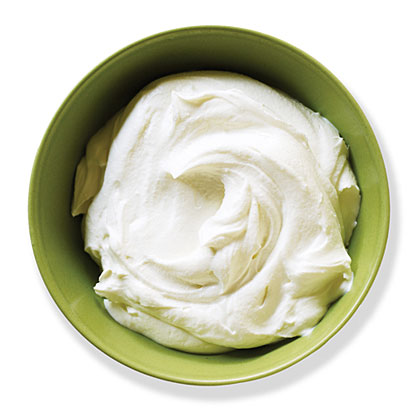

Step 1: "Ripen" the milk. Pour milk into an 8- to 10-qt. heavy-bottomed pot and insert dairy thermometer. Heat milk over medium-high heat to 85°, stirring often to prevent scorching. Remove from heat, remove thermometer, and sprinkle culture as evenly as possible over milk; let rest 10 minutes, then gently stir 1 minute in one direction. Dilute rennet in 2 tbsp. cool water and pour in evenly all over the milk; stir the same way. Dilute calcium chloride in 2 tbsp. cool water; pour and stir as you did the culture and rennet. Stir once in opposite direction to stop movement of milk. Cover with cheesecloth; let rest overnight on counter.
Step 2: Drain your curds. Ladle curds out of the pot into a large colander, lined with a double thickness of cheesecloth and set over a clean bucket. About 10 cups of whey will drain into the bucket; use for Homemade Ricotta (transfer whey to a bowl in the fridge whenever there's enough to collect). Drain curds 6 to 8 hours at room temperature, until the cheese resembles thick sour cream, scooping and turning with a soup spoon every hour or so in order to let the curds dry evenly.
Step 3: Dress your curds. Turn fromage blanc into a large bowl and stir in Crème Fraîche and salt to taste. Cheese is now ready to eat. It keeps, chilled in an airtight container, up to 1 week.
What you'll need:
These supplies may seem a bit mad-scientist, but they're easy to use. Find them—unless otherwise noted—at the Beverage People (thebeveragepeople.com or 800/544-1867). One very important note: Be scrupulously clean when making cheese—scrub surfaces with antibacterial soap and boil utensils (ladle, spoons, etc.) for 20 minutes before using. You don't want bad bacteria messing with the good.
Calcium chloride: A type of salt that helps firm up the curds.
Cheesecloth: A loosely woven cloth for lining cheese molds or colanders. Find at most grocery stores.
Ricotta mold: A small woven basket made of food-grade plastic; gives your ricotta a pretty shape.
Fromage blanc culture: Gives cheese both flavor and texture; looks a lot like freeze-dried yeast used for baking.
Dairy thermometer: Unlike a candy thermometer, measures low temperatures too. You can substitute an instant-read thermometer.
Vegetarian rennet: A lab-created version of the natural enzymes that coagulate milk.
Note: Nutritional analysis is per oz.
Servings 0
* Percent Daily Values are based on a 2,000 calorie diet. Your daily value may be higher or lower depending on your calorie needs.